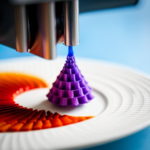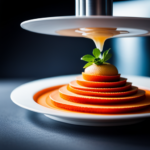In the world of culinary arts, the emergence of food 3D printers has sparked a paradigm shift, akin to the evolution from hand-drawn sketches to computer-generated designs in the world of architecture.
This technological innovation has not only enhanced culinary creativity but also enabled chefs to customize food designs with precision, expanding flavor possibilities and pioneering sustainable food production.
The implications are far-reaching, offering accessibility and shaping the future of gastronomy.
Enhanced Culinary Creativity
The integration of food 3D printers has significantly expanded the culinary creativity of chefs and food innovators, allowing for precise and intricate designs that were previously unattainable through traditional methods. These innovative techniques have revolutionized the way culinary professionals approach food presentation and artistic expression.
Through 3D printing, chefs can now experiment with textures, shapes, and structures, pushing the boundaries of traditional food artistry. The ability to fabricate edible sculptures, intricate garnishes, and personalized decorations has opened up a new realm of artistic expression within the culinary world.
Food 3D printers enable chefs to meticulously design and construct elaborate food displays, enhancing not only the visual appeal but also the overall dining experience for patrons. This level of precision and attention to detail was once a time-consuming endeavor but has now become achievable through the efficiency of 3D printing technology.
As a result, chefs can focus more on the creative aspect of their dishes, elevating their artistic capabilities and offering a truly unique and personalized culinary experience to their guests.
Customized Food Designs
Customized food designs are tailored to meet specific preferences and dietary requirements, showcasing the versatility and precision offered by food 3D printers in the culinary industry. This innovative technology allows for the creation of personalized nutrition, catering to individuals with unique dietary needs such as gluten-free, lactose intolerant, or high-protein diets.
Moreover, food 3D printers enable chefs to explore artistic plating by producing intricate and visually stunning dishes that were previously challenging to execute by hand.
-
Enhanced Personalization: Food 3D printers can precisely control ingredient composition and portion sizes, facilitating the customization of meals based on an individual’s nutritional needs and taste preferences.
-
Intricate Designs: The technology empowers chefs to craft elaborate and detailed food presentations, elevating the dining experience through visually appealing and aesthetically pleasing dishes.
-
Efficiency and Consistency: With 3D printing, chefs can consistently reproduce complex designs and patterns, ensuring that each dish meets the highest standards of presentation and taste, revolutionizing the culinary arts.
Precision in Food Presentation
Utilizing food 3D printers allows chefs to consistently achieve precision in food presentation, ensuring a high level of visual appeal and aesthetic quality in their dishes. Culinary artistry is taken to a new level as chefs can now create intricate and detailed designs that were once only achievable through painstaking manual labor. The precision offered by food 3D printers enables chefs to replicate complex patterns, shapes, and textures with accuracy, elevating the visual appeal of their culinary creations.
This level of precision not only enhances the artistic aspect of culinary creation but also contributes to the overall dining experience. Dishes are not only judged by taste but also by their visual appeal. With food 3D printers, chefs can meticulously craft visually stunning elements that captivate diners before the first bite. The precision in food presentation adds a new dimension to the dining experience, enhancing the anticipation and enjoyment of the meal.
Moreover, the ability to consistently reproduce intricate designs ensures that every dish maintains a high standard of visual appeal, reinforcing the reputation and brand of the chef or restaurant. This precision in food presentation is a testament to the transformative impact of food 3D printers on the culinary arts.
Expanding Flavor Possibilities
Leveraging food 3D printers enables chefs to broaden the range of flavors and textures they can create, revolutionizing the culinary landscape. With this technology, chefs can explore expanding flavor profiles and experiment with innovative ingredient combinations, leading to entirely new sensory experiences for diners. The possibilities are endless, from creating intricate layers of contrasting flavors to developing entirely new textures that were previously unattainable. This opens up a whole new world of culinary creativity and allows chefs to push the boundaries of traditional cooking.
Specifically, food 3D printers enable chefs to:
-
Infuse dishes with unexpected flavor combinations that surprise and delight the palate.
-
For example, combining savory and sweet elements in unique ways to create complex and harmonious taste experiences.
-
Craft textures that were previously impossible to achieve using conventional cooking methods.
-
For instance, creating delicate and crispy layers within a single dish to add depth and contrast.
-
Develop visually stunning dishes that not only taste exceptional but also engage all the senses.
This ability to expand flavor possibilities and innovate with ingredients sets the stage for a culinary revolution, where chefs can truly push the boundaries of what is possible in the kitchen. This shift in culinary creativity made possible by 3D food printing technology seamlessly aligns with the growing focus on sustainable food production.
Sustainable Food Production
How can food 3D printing technology contribute to more sustainable food production practices in the culinary industry?
Sustainable food production is a growing concern as the world grapples with environmental challenges and increasing food demands. Food 3D printers have the potential to address these issues by promoting sustainable agriculture and ethical consumption.
By using precise ingredient measurements, 3D food printing minimizes waste, ensuring that only the required amount of each ingredient is used. This not only reduces food waste but also encourages sustainable agricultural practices by promoting the efficient use of resources.
Furthermore, 3D food printers can utilize alternative and sustainable ingredients such as algae-based proteins or insect flours, offering new ethical consumption options. These printers can also create food designs that optimize the use of space, reducing the environmental impact of transportation and storage.
Culinary Arts Accessibility
The emergence of food 3D printers has democratized culinary skills, making it more accessible to a wider audience. This accessibility has not only expanded opportunities for individuals to explore their creativity in the culinary arts but has also paved the way for innovation and experimentation in food production.
As a result, culinary arts are no longer confined to traditional methods, but are now open to a broader spectrum of individuals, fostering a new era of culinary creativity and exploration.
Culinary Skills Democratized
Access to culinary skills is being democratized through the innovative use of food 3D printers. This technology enables democratized learning and culinary innovation by breaking down traditional barriers to entry in the culinary arts.
-
Accessibility: Food 3D printers provide an accessible platform for individuals to experiment with culinary creations without the need for extensive traditional cooking skills.
-
Customization: Users can customize their dishes with precision, allowing for personalized culinary experiences and the exploration of diverse flavor combinations.
-
Inclusivity: By simplifying complex cooking techniques, food 3D printers make culinary arts more inclusive, encouraging individuals from diverse backgrounds to engage in gastronomy.
As culinary skills become more accessible, the democratization of learning through technology fosters a new wave of culinary innovation and creativity.
This sets the stage for discussing how food 3D printers are enhancing culinary creativity.
Enhancing Culinary Creativity
Culinary arts accessibility is being enhanced through the integration of food 3D printers, fostering a new realm of culinary creativity and exploration. The utilization of innovative techniques allows chefs and culinary enthusiasts to push the boundaries of traditional food preparation, leading to an unprecedented level of artistic expression.
With the ability to precisely control ingredient placement and design intricate food structures, 3D food printing empowers chefs to experiment with unconventional shapes, textures, and flavors, ultimately redefining the culinary landscape.
This technology democratizes culinary artistry, providing a platform for individuals to unleash their creativity without the constraints of traditional cooking methods. As a result, food 3D printing not only revolutionizes the way food is prepared and presented but also encourages a more inclusive and diverse culinary community.
Future of Gastronomy
As we look toward the future of gastronomy, advancements in food 3D printing technology are poised to redefine the way we approach culinary creation and consumption.
The integration of artificial intelligence (AI) in food 3D printing processes will enable machines to learn from experience, optimize recipes, and even suggest innovative flavor combinations based on individual preferences.
Furthermore, virtual reality (VR) will play a pivotal role in the gastronomy of the future, allowing consumers to engage in immersive dining experiences that go beyond just taste and presentation.
These advancements will revolutionize the way we perceive and interact with food, blurring the lines between art, science, and gastronomy.
Through AI and VR, gastronomic experiences will become deeply personalized, offering consumers the ability to tailor their meals based on nutritional needs, dietary restrictions, and flavor profiles.
Additionally, virtual reality will transport diners to unique and fantastical environments, elevating the sensory experience and creating a new dimension of enjoyment in the culinary world.
Frequently Asked Questions
How Does 3D Printing Technology Impact the Nutritional Value of the Printed Food?
3D printing technology impacts the nutritional value of printed food by allowing for precise control over ingredient composition. This can affect taste and texture modification, enabling customization to meet specific dietary needs and preferences.
Are There Any Limitations to the Types of Ingredients That Can Be Used in Food 3D Printers?
The types of ingredients that can be used in food 3D printers are somewhat limited by the printing process. While traditional ingredients like dough and chocolate are easily printed, more complex ingredients may pose challenges in terms of texture and consistency.
Can Food 3D Printers Accommodate Dietary Restrictions and Allergies?
Food 3D printers can accommodate dietary restrictions and allergies by offering customized options. Allergen management is crucial, and ingredient compatibility is essential for nutritional balance. This technology enables tailored food production to meet diverse dietary needs.
What Are the Potential Environmental Impacts of Widespread Use of Food 3D Printers?
The widespread use of food 3D printers has the potential to positively impact environmental sustainability by reducing food waste. By precision printing ingredients, these printers minimize excess and promote sustainable practices, contributing to a more efficient and eco-friendly culinary industry.
How Do Food 3D Printers Affect the Traditional Roles of Chefs and Cooks in the Culinary Industry?
Food 3D printers are reshaping the traditional roles of chefs and cooks by impacting creativity and expanding culinary education opportunities. These devices introduce new methods of food preparation, challenging traditional techniques and encouraging innovative approaches in the culinary industry.
Conclusion
In conclusion, the integration of 3D printers in culinary arts has significantly expanded the creative possibilities and precision in food presentation.
This technological advancement has also opened doors for customized food designs and an array of flavor possibilities.
In addition, it has contributed to sustainable food production and increased accessibility in the culinary arts.
As the gastronomy industry continues to evolve, the future holds great potential for further innovation and transformation.


